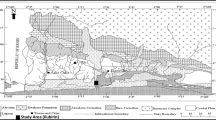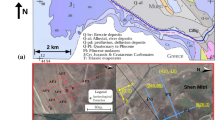Abstract
We present the practical application of a 3D electrical resistivity tomography (ERT) geophysical survey conducted in order to calculate the geometrical features and general structure of a construction and demolition waste layer in an old unregulated landfill prior to redevelopment. As traditional geological/geotechnical investigations comprised of cone penetration tests (CPT) failed to provide reliable results, primarily due to the nature of the underlying waste, a geophysical investigation was commissioned and found to be very effective in providing useful and accurate information to the project’s environmental and engineering team. The ERT survey data were collected in parallel equidistant lines and were subsequently merged and inverted as a single 3D dataset. The processed data depicted clearly the interface between the resistive construction waste and the conductive undisturbed host clay layer ranging at depths between 3 and 11 m. As a result of this successful geophysical investigation the total volume of the solid waste materials was calculated to be about 32500 m3. Following the complete removal of the waste it became evident that the ERT geophysical survey results were particularly accurate. As a result, the reclamation constructor was able to carefully plan the required resources for excavating, moving and disposing of the waste. Interpreted ERT data not only defined the thickness of the debris layer and the total volume with a deviation of less than 10%, but also revealed the inner structure of the solid waste layer.
Similar content being viewed by others
References
Aizebeokhai A.P., Olayinka A.I. and Singh V.S., 2010,. Application of 2D and 3D geoelectrical resistivity imaging for engineering site investigation in a crystalline basement complex terrain southwestern Nigeria. Environ. Earth Sci., 61, 1481–1492.
Chambers J.E, Ogilvy R.D., Kuras O. and Meldrum P.I., 2002,. 3D electrical imaging of known targets at a controlled environmental test site. Environ. Geol., 41, 690–704.
Chambers J., Kuras O., Meldrum P., Ogilvy R. and Hollands J., 2006,. Electrical resistivity tomography applied to geologic, hydrogeologic, and engineering investigations at a former waste-disposal site. Geophysics, 71(6), B231–B239.
Chambers J.E., Wilkinson P.B., Wardrop D., Hameed A., Hill I., Jeffrey C., Loke M.H., Meldrum P.I., Kuras O., Cave M. and Gunn D.A., 2012,. Bedrock detection beneath river terrace deposits using three-dimensional electrical resistivity tomography. Geomorphology, 177-178, 17–25.
Chiampo F., Conti R. and Cometto D., 1996,. Morphological characterization of MSW landfills. Resour. Conserv. Recycl., 17, 37–45.
Dahlin T., Bernstone C. and Loke M.H., 2002,. Case history: A 3-D resistivity investigation of a contaminated site at Lernacken, Sweden. Geophysics, 67, 1692–1700.
Drahor M.G., Berge M.A., Kurtulmuş T.Ö., Hartmann M. and Speidel M.A., 2008,. Magnetic and electrical resistivity tomography investigations in a Roman legionary camp site (Legio IV Scythica) in Zeugma, Southeastern Anatolia, Turkey. Archaeol. Prospect., 15, 159–186
Emberton J.R. and Parker A., 1987,. The problems associated with building on landfill sites. Waste Manage. Res., 5, 473–482.
Fatta D., Papadopoulos A., Avramikos E., Sgourou E., Moustakas K., Kourmoussis F., Mentzis A. and Loizidou M., 2003,. Generation and management of construction and demolition waste in Greece - an existing challenge. Resour. Conserv. Recycl., 40, 81–91.
Guerin R., Begassat Ph., Benderitter Y., David J., Tabbagh A. and Thiry M., 2004,. Geophysical study of the industrial waste land in Mortagne-du-Nord (France) using electrical resistivity. Near Surf. Geophys., 3, 137–143.
Gharibi M. and Bentley L.R., 2005,. Resolution of 3-D electrical resistivity images from inversions of 2-D orthogonal lines. J. Environ. Eng. Geophys., 10, 339–349.
Kim J.H., 2009,. DC2DPro-2D Interpretation System of DC Resistivity Tomography. User’s Manual and Theory, KIGAM, S. Korea.
Kockel F., Mollat H., Antoniades P.H. and Papadopoulos P., 1970,. Geological Map of Greece, Thermi Sheet. Scale 1:50.000. IGME, Athens, Greece.
Loke M.H. and Barker R.D., 1996,. Practical techniques for 3D resistivity surveys and data inversion. Geophys. Prospect., 44, 499–523.
Loke M.H., Chambers J.E., Rucker D.F., Kuras O. and Wilkinson P.B., 2013,. Recent developments in the direct-current geoelectrical imaging method. J. Appl. Geophys., 95, 135–156.
Lunne T., Robertson P.K. and Powell J.J.M., 1997,. Cone Penetration Testing in Geotechnical Practice. Blackie Academic & Professional, New York.
Merino M., Gracia P. and Azevedo I., 2010,. Sustainable construction: construction and demolition waste reconsidered. Waste Manage. Res., 28, 118–129.
Matasovic N., El-Sherbiny R. and Kavazanjian E., 2008,. In-situ measurements of MSW properties. In: Zekkos D. (Ed.), Geotechnical Characterization, Field Measurement and Laboratory Testing of Municipal Solid Waste. ASCE Geotechnical Special Publication No.209., American Society of Civil Engineers, New York, DOI: 10.1061/9780784411469.
Negri S., Leucci G. and Mazzone F., 2008,. High resolution 3D ERT to help GPR data interpretation for researching archaeological items in a geologically complex subsurface. J. Appl. Geophys., 65, 111–120.
Porsani J.L., Filhob W.M., Vagner R.E., Shimelesa F., Douradob J.C. and Moura H.P., 2004,. The use of GPR and VES in delineating a contamination plume in a landfill site: a case study in SE Brazil. J. Appl. Geophys., 55, 199–209.
Papadopoulos N.G., Tsourlos P., Tsokas G.N. and Sarris A., 2006,. Two-dimensional and threedimensional resistivity imaging in archaeological site investigation. Archaeol. Prospect., 13, 163–181.
Seger M., Cousin I., Frison A., Boizard H. and Richard G., 2009,. Characterization of the structural heterogeneity of the soil tilled layer by using in situ 2D and 3D electrical resistivity measurements. Soil Tillage Res., 103, 387–398.
Soupios P., Papadopoulos I., Kouli M., Georgaki I., Vallianatos F. and Kokkinou E., 2007,a. Investigation of waste disposal areas using electric methods: A case study from Hania - Crete, Greece. Environ. Geol., 53, 661–675.
Soupios P.M., Georgakopoulos P., Papadopoulos N., Saltas V., Andreadakis A., Vallianatos F., Sarris A. and Makris J.P., 2007,b. Use of engineering geophysics to investigate a site for a building foundation. J. Geophys. Eng., 4, 94–103.
Stummer P. 2003. New Develpments in Electrical Resistivity Imaging. PhD Thesis. Swiss Federal Institute of Technology, Zurich, Switzerland (http://e-collection.library.ethz.ch/eserv/eth:26405/eth-26405-02.pdf).
Tabbagh A., Dabas M., Hesse A. and Panissod C., 2000,. Soil resistivity: a non-invasive tool to map soil structure horizonation. Geoderma, 97, 393–404.
Townsend T., Jang Y. and Thurn L., 1999,. Simulation of construction and demolition waste leachate. J. Environ. Eng., 125, 1071–1081.
Tsourlos P., 1995,. Modelling, Interpretation and Inversion of Multielectrode Resistivity Survey Data. PhD Thesis. University of York, York, U.K.
Yi M.J., Kim J.H., Song Y., Cho S.J., Chung S.H. and Suh J.H., 2001,. Three-dimensional imaging of subsurface structures using resistivity data. Geophys. Prospect., 49, 483–497.
Author information
Authors and Affiliations
Corresponding author
Rights and permissions
About this article
Cite this article
Vargemezis, G., Tsourlos, P., Giannopoulos, A. et al. 3D electrical resistivity tomography technique for the investigation of a construction and demolition waste landfill site. Stud Geophys Geod 59, 461–476 (2015). https://doi.org/10.1007/s11200-014-0146-5
Received:
Revised:
Accepted:
Published:
Issue Date:
DOI: https://doi.org/10.1007/s11200-014-0146-5




